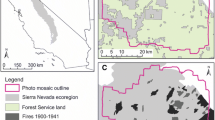Abstract
The objective of this study was to develop a technique to classify health of eastern hemlock stands using historical satellite images. While remote sensing and geographic information systems have been used successfully to classify forest health using recent images, applying this process to older images is problematic because contemporaneous field data are not available to measure the accuracy of the classification of historical images. Data ranges were established for each hemlock health class using a contemporary image and field data. These ranges were used to level-slice archived images to create a series of health-class maps that show changes in forest health over time. By applying cross-tabulation procedures to pairs of classified images, it is possible to construct a transition map that indicates how the hemlock health class of each pixel in the images of the study area has changed over time. The resulting maps provide a look back at forest conditions of the past and can be used to identify areas of special interest.
Similar content being viewed by others
References
Benzinger J (1994) Hemlock decline and breeding birds. Records of New Jersey Birds 20(1): 2–12
Bonneau LR, Shields KS and Civco DL (1999) Using satellite images to classify and analyze the health of hemlock forests infested by the hemlock woolly adelgid. Biological Invasions 1: 255–267 (this issue)
Chavez PS (1988) An improved dark-object subtraction technique for atmospheric scattering correction of multispectral data. Remote Sensing of the Environment 24: 459–479
Congalton RG (1991) A review of assessing the accuracy of classifications of remotely sensed data. Remote Sensing of the Environment 37: 35–46
Crist EP and Cicone RC (1984) Application of the Tasseled Cap concept to simulated thematic mapper data. Photogrammetric Engineering & Remote Sensing 50: 343–352
Dickson DR and McAfee CL (1988) Forest statistics for Connecticut — 1972 and 1985. USDA Forest Service Resource Bulletin NE-105
Goodman RM and Lancaster K (1990) Tsuga canadensis — Eastern hemlock in Silvics of North America: Volume 1 Conifers. USDA Forest Service Agriculture Handbook, 654 pp
Hill DE, Sautter EH and Gonick WN (1980) Soils of Connecticut. Bulletin of the Connecticut Agricultural Experiment Station 787, 36 pp
Jenkins JC, Aber JD and Canham CD (1999) Hemlock woolly adelgid impacts on community structure and N cycling rates in eastern hemlock forests. Canadian Journal of Forest Research 29: 630–645
Jorgensen N (1978) A Sierra Club Naturalist's Guide — Southern New England. Sierra Club Books, San Francisco, 417 pp
Joria PE, Ahearn SC and Connor M (1991) A comparison of the SPOT and Landsat Thematic Mapper Satellite Systems for detecting Gypsy moth defoliation in Michigan. Photogrammetric Engineering & Remote Sensing 57: 1605–1612
Kriegler FJ, Malila WA, Nalepka RF and Richardson W (1969) Preprocessing transformations and their effects on multispectral recognition. In: Proceedings of the Sixth International Symposium on Remote Sensing of Environment, pp 97–131. University of Michigan, Ann Arbor, Michigan
McClure M (1987) Hemlock woolly adelgid may also attack spruce. Frontiers of Plant Science, Connecticut Agricultural Experiment Station, New Haven, 39: 7–8
McClure M (1991) Pesticides will protect ornamentals from hemlock woolly adelgid. Frontiers of Plant Science, Connecticut Agricultural Experiment Station, New Haven, 43: 2–3
McClure M (1994) Is there any hope for hemlock? Connecticut Woodlands 59(3): 5–6
Millers I, Anderson R, Burkman W and Hoffard W (1992) Forest health monitoring crown condition rating guide. USDA, Forest Service, State and Private Forestry, Northeast Area and Southern Region
Muchoney DM and Haack BN (1994) Change detection for monitoring forest defoliation. Photogrammetric Engineering & Remote Sensing 60: 1243–1251
Orwig DA and Foster DR (1998) Forest response to the introduced hemlock woolly adelgid in southern New England, USA. Journal of the Torrey Botanical Society 125(1): 60–73
Qi J, Chehbouni A, Huete AR, Kerr YH and Sorooshian S (1994) A modified soil adjusted vegetation index. Remote Sensing of the Environment 48: 119–126
Quimby JW (1996) Value and importance of hemlock ecosystems in the eastern United States. In: Salmon SM, Tigner TC and Reardon RC (eds) Proceedings of the First Hemlock Woolly Adelgid Review, Charlottesville, Virginia, USA, 12 October 1995, USDA Forest Service, Forest Health Technology Team, Morgantown, West Virginia, pp 1–8
Royle DD and Lathrop RG (1997) Monitoring hemlock forest health in New Jersey using Landsat TM data and change detection techniques. Forest Science 43(3): 327–335
Sharp EL, Perry CR, Scharen AL, Boatwright GO, Sands DC, Lautenschlager LF, Yahyaoui CM and Ravet FW (1985) Monitoring cereal rust development with a spectral radiometer. Phytopathology 75: 936–939
Suoto D, Luther T and Chianese R (1996) Past and current status of HWA in eastern and Carolina hemlock stands, In: Salmon SM, Tigner TC and Reardon RC (eds) Proceedings of the First Hemlock Woolly Adelgid Review, Charlottesville, Virginia, USA, 12 October 1995, USDA Forest Service, Forest Health Technology Team, Morgantown, West Virginia, pp 9–15
Vogelmann JE and Rock BN (1988) Assessing forest damage in high-elevation coniferous forests in Vermont and New Hampshire using thematic mapper Data. Remote Sensing of the Environment 24: 227–246
Young RF, Shields KS and Berlyn GP (1995) Hemlock woolly adelgid (Homoptera: Adelgidae): stylet bundle insertion and feeding sites. Annals of the Entomological Society of America 88: 827–835
Author information
Authors and Affiliations
Corresponding author
Rights and permissions
About this article
Cite this article
Bonneau, L.R., Shields, K.S. & Civco, D.L. A Technique to Identify Changes in Hemlock Forest Health over Space and Time Using Satellite Image Data. Biological Invasions 1, 269–279 (1999). https://doi.org/10.1023/A:1010081832761
Issue Date:
DOI: https://doi.org/10.1023/A:1010081832761




